1. INTRODUCTION
The conventional methods used for measuring the age of trees include the tree-ring observation method, stem node observation method, and diameter measuring method. Although tree-ring observation is the most accurate of these methods (Jeong et al., 2017; Seo et al., 2017a, b), cases wherein this method is actually used are rare. This is because scars occurring from the collection of increment cores can damage the growth and development of big old trees and can wither them. However, trees can prevent moisture evaporation and can mitigate the invasion of germs in case of scars (Shigo et al., 1977; Dujesiefken et al., 2006). Furthermore, the cambiums and oil cells around the scar create wound tissues that to cover a scar using a different mechanical and chemical characteristics than that normal cells (Grunwald et al., 2002; Frankenstein et al., 2005), which do not hinder the growth and development (Oh et al., 2017).
A resistograph was developed for measuring the inner condition of trees and the degree of decomposition of wood materials by inserting a needle into the tree and displaying the difference in the electric resistance, which were caused by the density difference of the xylem, in the form of a graph (Frank, 1994; Gruber, 2000). In countries other than Korea, resistograph is mainly used to calculate the degree of decomposition of trees (Fikret, et al., 2003; Denise, 2010; Frank, 2013) or for confirming the degree of decomposition of materials in ancient architecture (Ceraldi et al., 2001), analyzing the formation and decomposition of the callus caused by forest fires (Michael et al., 2003) or analyzing the shape of trees affected by landslides (Saez et al., 2008). In Korea, it has been verified that the materials of wooden cultural assets and wooden installations can be evaluated using resistograph (Lee et al., 2003; Hwang et al., 2008), and it is often used for a non-destructive diagnosis to analyze the degree of decomposition of wooden materials (Jung et al., 2014; Lee et al., 2014).
Studies that measured tree ages using resistograph and aimed to verify decomposition are rare. Resistograph can distinguish earlywood and latewood at the site using graphs, but due to the problems associated with the sensor that hinders distinguishing between earlywood and latewood, it is difficult to measure the ages of big old trees or trees with hard trunks (Son, 2007). However, cases of measuring tree ages using resistograph have been reported recently. Bilgin et al. (2012) verified whether resistograph can be used for measuring ages of needleleaf trees with distinct tree rings and reported that it is possible to measure ages of P. brutia. A previous study evaluated the ages by putting the relation of the diameter at breast height and the age of trees into a regression equation, and compared the result with the tree age measured by resistograph. The usefulness of resistograph was also verified in a study (Lukaszkiewicz et al., 2005). However, there are hardly any studies conducted outside Korea that used resistograph to investigate tree ages. Therefore, this study aims to measure the age of trees using a distinct boundary of tree rings with resistograph and reviewed the possibility of resistograph for estimating tree ages.
2. MATERIALS and METHODS
Disks of 5 tree species, namely Larix kaempferi, Pseudotsuga menziesii, Pinus koraiensis, Abies holophylla, and Zelkova serrata, with a distinct boundary of tree rings were prepared to determine the number of tree rings using resistograph (Table 1).
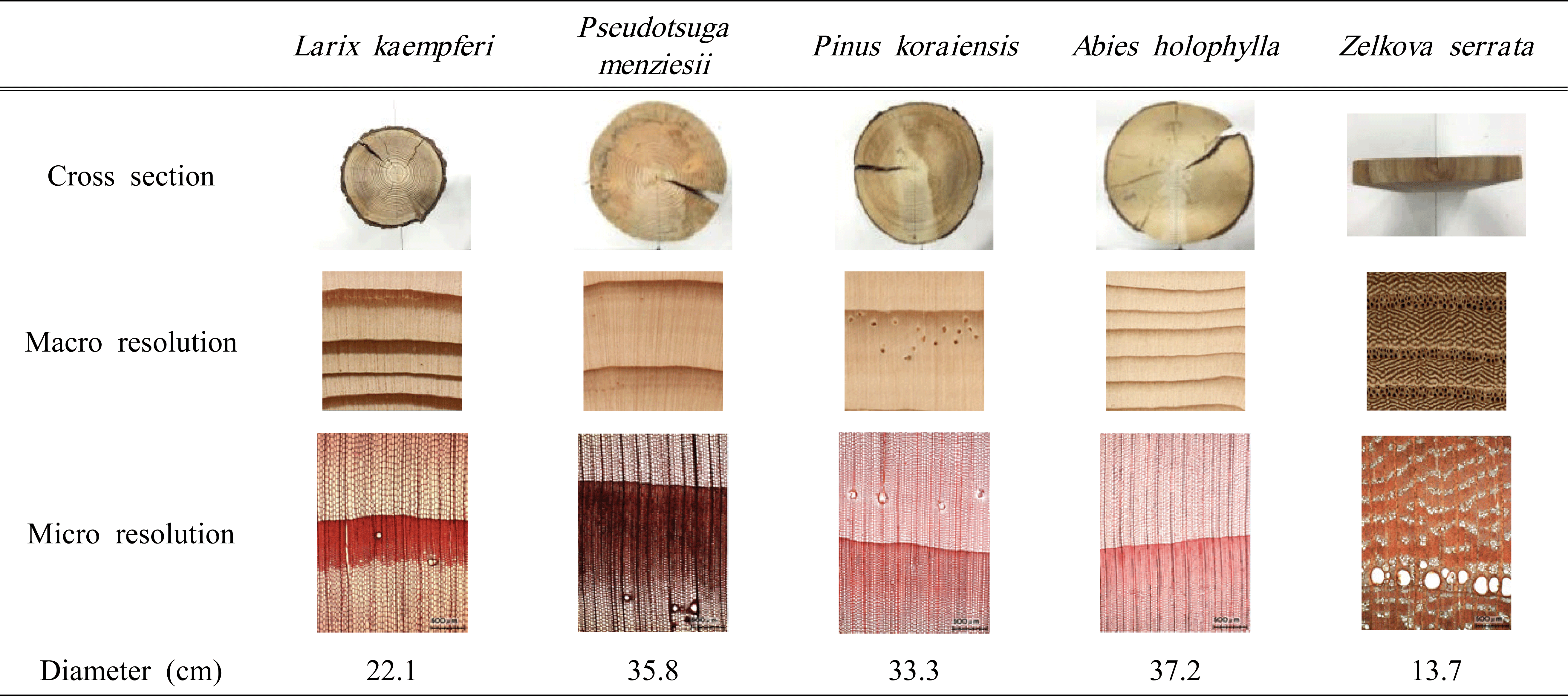
|
LINTAB system and resistograph were used to measure tree rings aligned in the direction to the measuring needle of resistograph (Fig. 1) is inserted. It is more stable and tree-ring boundaries are clear when the amplitudes of the graph are within the range of 40%–60% (IML Australia ⓒ, 2013). For the needle and feed speeds of resistograph, stable amplitudes based on the latewood percentage were used.
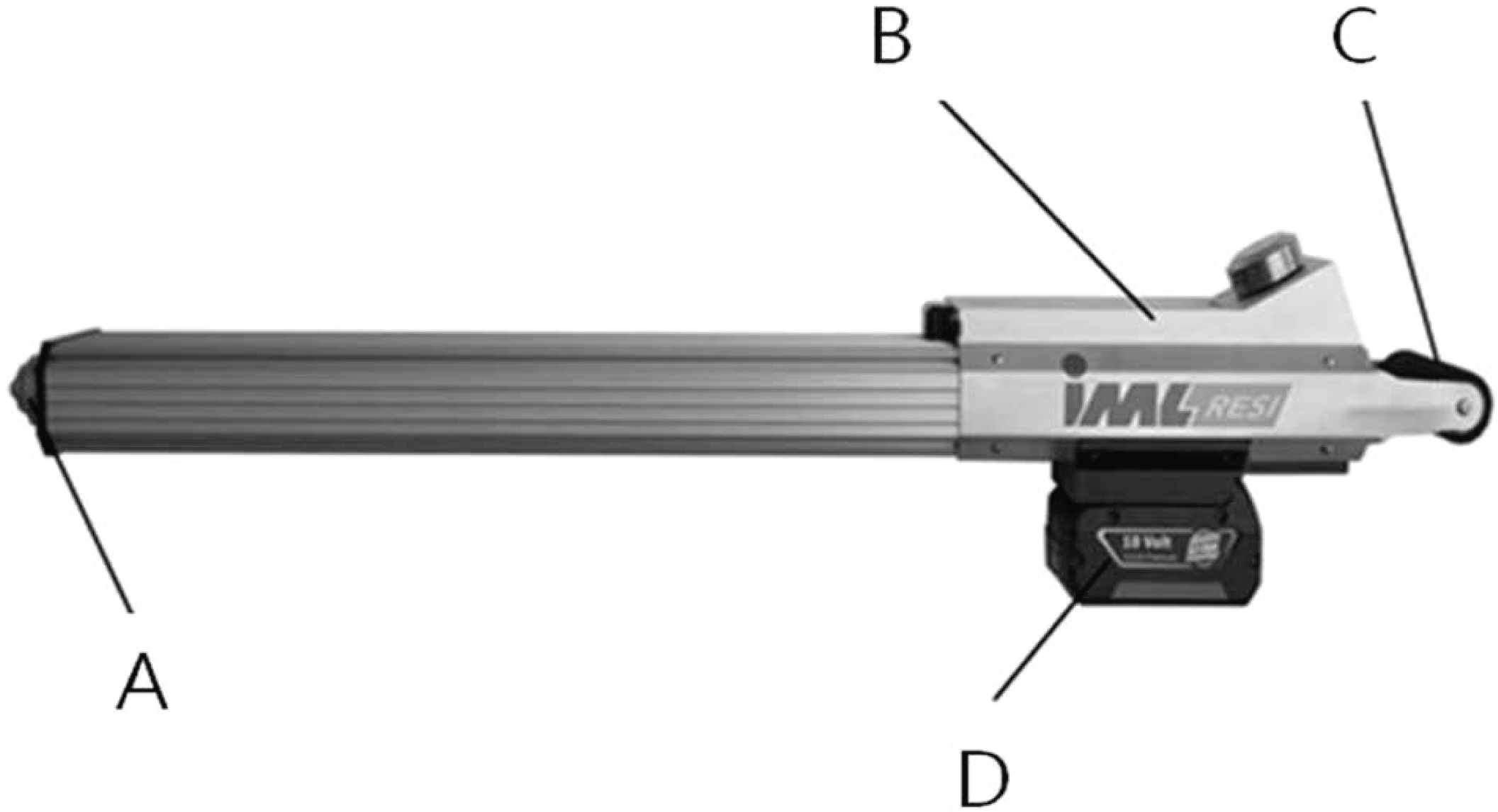
The tree-ring widths of graphs drawn by resistograph were digitalized (PD-tool pro, Fig. 2). The accuracy of the equipment was verified by comparing the digitalized tree-ring widths with the tree-ring width graphs measured by LINTAB.
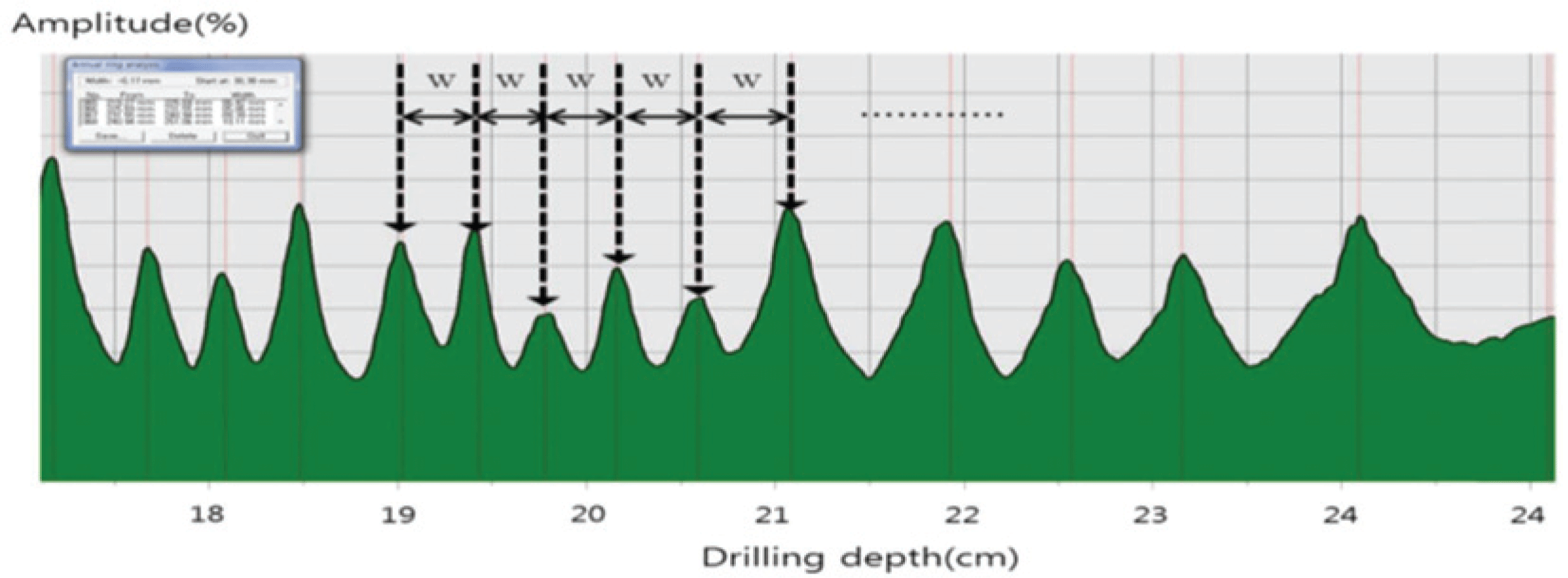
3. RESULTS and DISCUSSION
As a result of measuring tree ages using the age measurer, larch (Larix kaempferi) had 36 tree rings and 27.92% of average latewood width, douglas fir (Pseudotsuga menziesii) had 29 tree rings and 31.71% of the average latewood width, Korean pine (Pinus koraiensis) had 36 tree rings and 12.94% of the average latewood width, fir (Abies holophylla) had 32 tree rings and 14.53% of the average latewood width, and zelkova (Zelkova serrata), broadleaf trees, had 63 tree rings and 76.15% of the average latewood width (Table 2). It is reported that the stable amplitude range for analyzing tree ages using resistograph is 40%–60% (IML Australia ⓒ, 2013). To investigate the needle and feed speeds within this range, different needle and feed speeds were used based on the latewood percentage for each tree species to measure the resistance value of tree rings (Ukrainetz et al., 2010; Frank, 2012). Resultantly, the tree-ring boundaries clearly appear at 1,500 r/min of needle speed regardless of tree species (Fig. 3). Zelkova (latewood percentage: 75.07%) with a high percentage of latewood used the slowest feed speed of 75 cm/min. Larch (latewood percentage: 27.92%) and douglas fir (latewood percentage: 31.71%), which have a medium percentage of latewood, used a feed speed of 100 cm/min. Korean pine (latewood percentage: 12.94%) and fir (latewood percentage: 14.53%), which have a low percentage of latewood, used feed speeds of 150 and 175 cm/min, respectively, to verify stable amplitudes and distinct tree-ring boundaries (Table 2). Fig. 4 shows the amplitudes and distinct tree-ring boundaries of fir and zelkova.
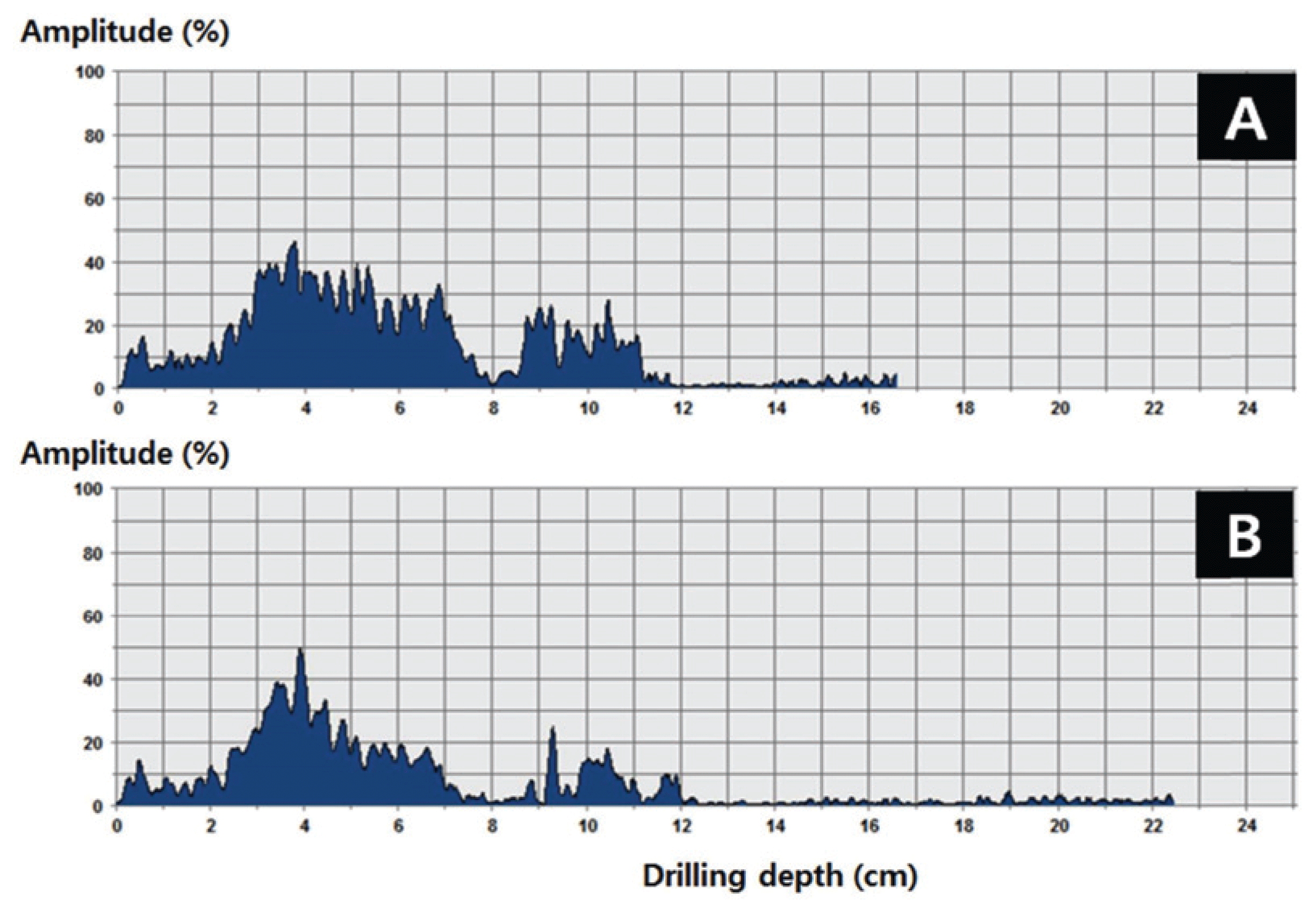
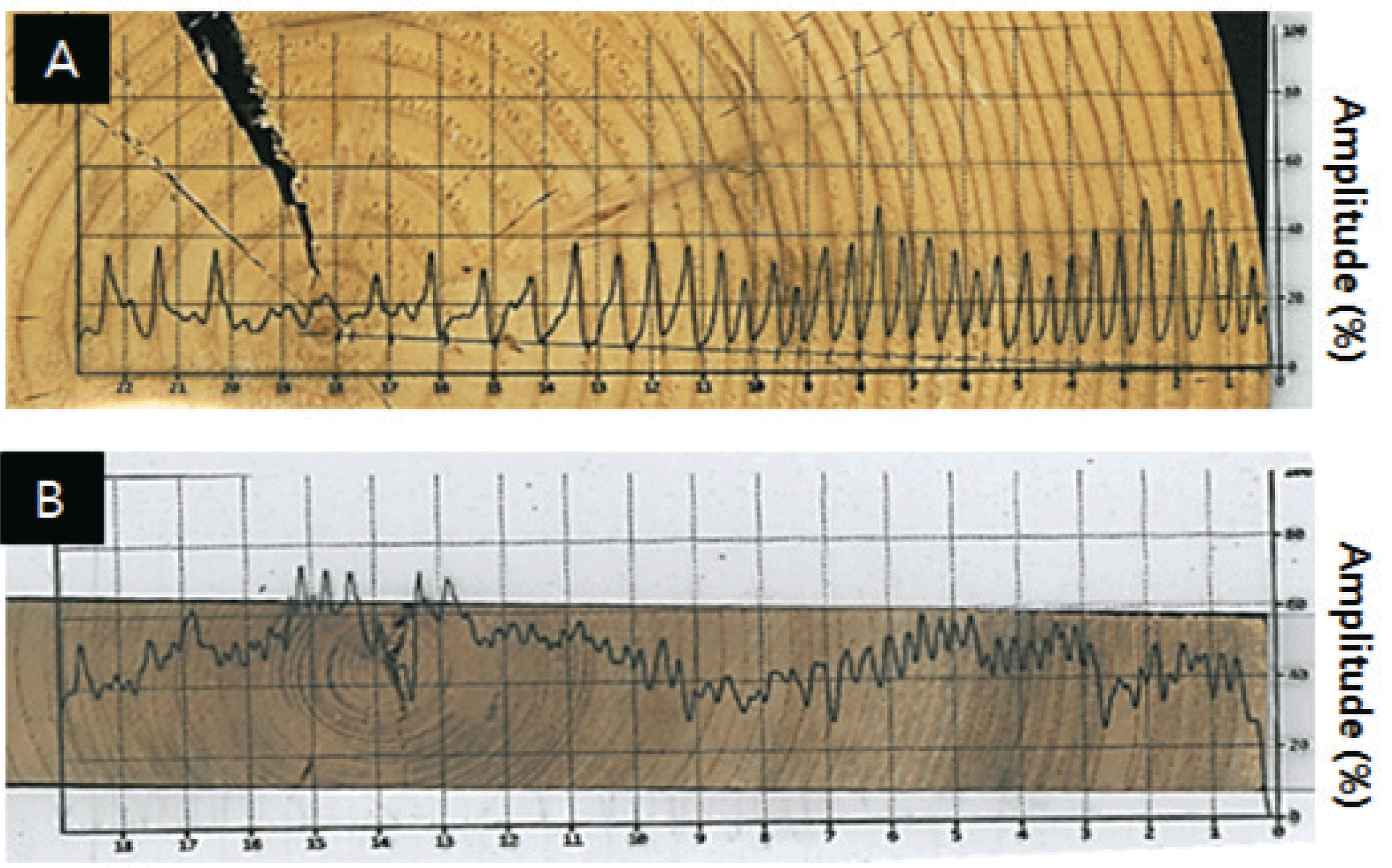
Table 3 lists the measurement results of tree-ring widths of 5 disks using LINTAB and resistograph. Upon comparing the mean tree-ring widths measured using both the methods, larch, douglas fir, and Korean pine showed the differences of 0.03, 0.08, and 0.01 mm, respectively. Fir and zelkova showed the same values. Table 4 lists the number of tree rings of 5 disks measured by LINTAB and resistograph. Except for larch which had 4 differences, all showed the same number of tree rings.
Upon comparing the 5 species with LINTAB and resistograph, all species except for zelkova had similar patterns. Fig. 5 shows the comparison of LINTAB and resistograph of fir, and they correspond approximately. In the case of zelkova, narrow tree rings were distributed on the whole regardless of heartwood and sapwood. In particular, the mean tree-ring width from the 6th to 29th was 0.15 mm (Fig. 6). The sapwood part of larch had the mean tree-ring width of 0.07 mm and narrow tree rings of sapwood cause the difference in the number of tree rings (Fig. 7). Therefore, it seems that the narrow tree rings bring the difference in the number of tree rings between 2 measurement methods (Eckstein et al. 1994) and it is difficult to accurately measure narrow tree rings with resistograph.



As a result of the statistical comparison, all tree species except zelkova showed statistically significant t values of over 3.5 (Table 5). In the case of zelkova, the t value was 0.8 because it was impossible to measure the accurate width of tree rings due to the tree rings being narrower than 1 mm. The Glk values for verifying the conformity of code were 91% for larch, 82% for douglas fir, 83% for Korean pine, and 92% for fir, which were statistically significant (Table 6). In the case of zelkova, the high conformity was shown except for the tree rings from 1 to 20, which are narrow rings with inconsistent cross-dating, in macroscopy (Fig. 8). It also showed statistically significant results with the t value of 4.2 (overlap period 42) and the Glk value of 68%. Thus, measuring tree ages with resistograph can be used in species with distinct tree rings with over 1 mm in width, and it is possible to measure accurate tree ages by analyzing the tree-ring width graph using resistograph and graph by cross-dating. Additionally, the tree-ring width graph of resistograph can be used to investigate the growth increment.
| Larch | Douglas fir | Korean pine | Fir | Zelkova | |
|---|---|---|---|---|---|
| Larch-R | 10.3(33*) | ||||
| Douglas fir-R | 4.9(82*) | ||||
| Korean pine-R | 8.9(83*) | ||||
| Fir-R | 10(92*) | ||||
| Zelkova-R | 0.8(63*) |
| Larch | Douglas fir | Korean pine | Fir | Zelkova | |
|---|---|---|---|---|---|
| Larch-R | 91% | ||||
| Douglas fir-R | 82% | ||||
| Korean pine-R | 83% | ||||
| Fir-R | 92% | ||||
| Zelkova-R | 60% |

4. CONCLUSION
This study was conducted to find the most proper resistograph needle and feed speeds to investigate the number of tree rings in different tree species. Larix kaempferi, Pseudotsuga menziesii, Pinus koraiensis, Abies holophylla, and Zelkova serrata with distinctive tree-ring boundaries were used for the test. It was found that the most proper needle speed was 1,500 r/min, wherein the tree-ring boundaries appeared clearly. The most proper feed speed for Zelkova serrata, Larix kaempferi, Pseudotsuga menziesii, Abies holophylla, and Pinus koraiensis was 75, 100, 100, 150, and 175 cm/min, respectively. The LINTAB and resistograph graphs agreed as well. However, in all species, the widths of tree ring narrower than 1 mm were not suitable for determining tree-ring boundaries. If resistograph could be improved to measure tree ring narrower than 1 mm, it could displace the conventional tree-ring observation method for counting the number of tree rings in increment cores with resistograph. Additionally, tree-ring width graphs can be used to investigate the tree growth.
